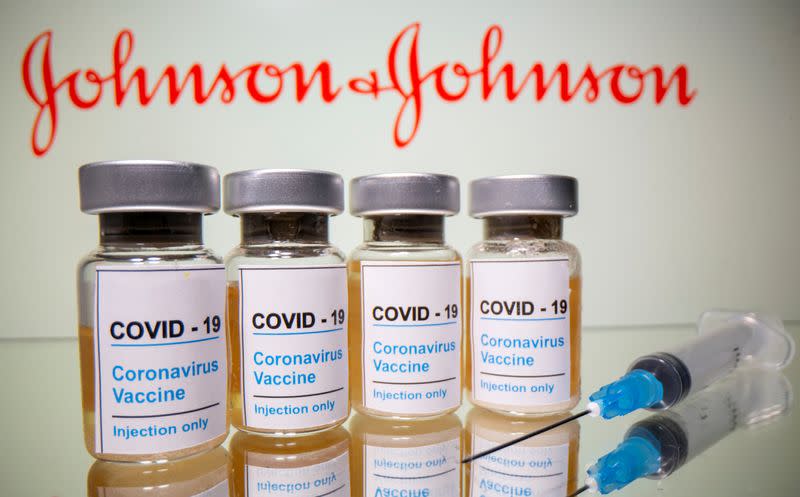By Nancy Lapid
(Reuters) – The following is a summary of some of the latest scientific studies on the new coronavirus and efforts to find treatments and vaccines for COVID-19, the disease caused by the virus.
Johnson & Johnson vaccine advancing through clinical trials
A Johnson & Johnson COVID-19 experimental vaccine produced protective antibodies against the new coronavirus in 90% of the 805 volunteers in 29 days, and this increased to 100% on day 57, according to data from an ongoing intermediate-stage study. Side effects, such as fever, muscle pain and at the injection site, resolved quickly, the researchers reported on Wednesday in the New England Journal of Medicine. To be approved by regulators, the J&J vaccine must show effectiveness as reflected by a lower risk of infections and serious illnesses in study participants who receive it compared to those who do not. The efficacy data for a large end-stage vaccine trial is due to be released in February. Experts expect the vaccine to show 80% or more effectiveness, which would exceed the 50% benchmark for regulatory approval, but lags behind the 95% achieved in vaccine trials already authorized by Moderna Inc and Pfizer Inc with BioNTech SE. The J&J vaccine requires only a single dose and does not have the cold storage requirements of other vaccines. The likelihood of good results “hopefully is very high,” said Paul Stoffels, chief scientific officer at the New Brunswick, New Jersey company this week. (https://bit.ly/2LpBhHm)
COVID-19 gives some immunity, and reinfections are seen as rare
Survivors of COVID-19 are highly likely to have some immune protection against the virus for at least five months, and reinfections in recovered patients are rare, with only 44 cases found among 6,614 people previously infected, according to researchers who lead a large ongoing study of health care workers in Britain. But when people take COVID-19 a second time, they usually have no symptoms and therefore can still carry the coronavirus in their nose and throat and, unintentionally, pass it on, the researchers wrote in a report published on Wednesday by Public Health England (PHE) ahead of the peer review. Experts said people who contracted COVID-19 in the first wave of the pandemic may now be vulnerable to the infection again. “We now know that most of those who have had the virus and developed antibodies are protected against reinfection, but that is not total and we still don’t know how long the protection lasts,” said study leader Susan Hopkins, senior medical consultant at PHE in London. “If you believe you have had the disease and are protected, you can be sure that it is highly unlikely that you will develop serious infections. But there is still a risk of acquiring an infection and passing it on to others.” (https://bit.ly/3ihkuBZ; https://reut.rs/3ieWorA)
Coronavirus targets the energy engines of cells
The researchers found an important line of attack used by the new coronavirus: it targets the mitochondria of an infected cell. These tiny organelles not only generate the energy that fuels a cell’s biochemical reactions, but also play important roles in immune function. “We knew that when the virus attacks cells, bad things happen – but we didn’t know why,” said Dr. Pinchas Cohen, of the University of Southern California, whose team published their findings this month in the journal Scientific Reports. “Now we can say that when the virus attacks cells, it damages mitochondria.” In experiments in test tubes, the researchers found that the virus caused “dramatic changes and damage” in the genes that regulate mitochondrial function, Cohen told Reuters. The implication, Cohen said, is that energy production in cells and so-called innate immunity – the body’s first line of defense against germs – are impaired. Another implication is that having healthy mitochondria would help people fight the virus if they were infected. “We know that a healthy diet and a healthy lifestyle promote mitochondrial health,” said Cohen, while mitochondrial function deteriorates with age and many chronic conditions, including diabetes and heart disease. In the future, added Cohen, researchers may develop COVID-19 interventions to help improve mitochondrial health. (https://go.nature.com/3bFlCyc)
Combinations of ‘nanobody’ block coronavirus, even when it mutates
Combining small antibodies called nanobodies into single molecules to fight the new coronavirus may be more effective than targeting it with conventional antibodies or single nanobodies, according to a new study. These “multivalent” nanobodies – containing several nanobody building blocks – “are substantially better at neutralizing viruses” and preventing them from invading cells, study leaders Florian Schmidt and Paul-Albert König at the University of Bonn told Reuters . The fused nanobodies “help each other so that the result is better than just the sum of the two responses.” Nanobodies can target multiple sites in the coronavirus, making it more difficult for the pathogen to develop mutations that render treatment ineffective, according to a report published Tuesday in Science. Although the researchers saw many mutations that allowed the coronavirus to “escape” the effect of a single nanobody, “we found no escape mutants capable of replicating in the presence of these nanobodies that target two different surfaces at the same time,” Schmidt and König said. A spin-off company from the University of Bonn, called DiosCURE, hopes to start testing the combined nanocorp molecules in people later this year. (https://bit.ly/3nOvXKH)
Open https://tmsnrt.rs/3a5EyDh in an external browser to see a Reuters graph of vaccines and treatments under development.
(Reporting by Nancy Lapid and Kate Kelland; Editing by Will Dunham)
